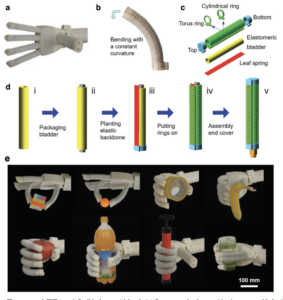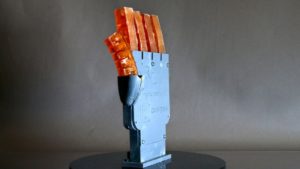Piab has extended its piSoftgrip family with a new pinch gripper developed for the automation of the food/chocolate industry. The vacuum-based soft gripper can grip sensitive and lightweight oblong objects with odd geometries and/or objects with an unusual surface. piSoftgrip has two gripping fingers and a sealed vacuum cavity, all made in one piece, resulting…
Metamaterials could lead to transforming robots, say U.S. Army, MIT researchers
The U.S. Army and MIT are exploring how metamaterials can help form modular robotic building blocks for transforming robots that can be reconfigured into different shapes and functions.
Soft robotic gripper modeled after an elephant’s trunk
Nature has inspired engineers at UNSW Sydney to develop a soft fabric robotic gripper that behaves like an elephant’s trunk to grasp, pick up and release objects without breaking them. The researchers say the versatile technology could be widely applied in sectors where fragile objects are handled, such as agriculture, food and the scientific and…
Wearable robots are ready to leave the lab, says Harvard researcher Conor Walsh
In his RoboBusiness Direct session, recognized Harvard University professor Conor Walsh will examine how his team or researchers have developed soft, wearable robotics for industrial use.
Toyota Research Institute shows service robot prototypes in virtual open house
Toyota Research Institute demonstrated its research into machine learning, simulation, and manipulation in a virtual open house, which included a ceiling-mounted kitchen gantry robot.
Exosuit developed at Vanderbilt University found to reduce lower back muscle fatigue
Vanderbilt University researchers say they have determined that a wearable exosuit they designed can relieve fatigue by 29% to 47% in lower back muscles.
Soft Bubble Gripper a step toward domestic robots, says Toyota Research Institute
The Soft Bubble Gripper developed by a Toyota Research Institute team combines sensors and advanced materials to more safely handle objects in a step toward household robots.
Ironhand soft robotic glove uses FAULHABER drives to help reduce worker strain
FAULHABER’s 1741 … CXR series DC micromotors provide power to Bioservo Technologies’ Ironhand wearable glove. The exoskeleton is designed to reduce worker strain.
The Gripper Company opens online store with configurable soft gripper
The Gripper Company opened its online shop for business with its first offering — a configurable soft gripper to meet demand for handling diverse objects while trying to keep costs down.
Root AI raises seed funding for Virgo robot, designed to harvest multiple crops
Root AI, which has been developing the Virgo robot to be able to pick multiple types of crops with AI and compliant fingers, plans to expand in North America and Europe.
Michigan State finds that stronger soft gripper could lead to safer human-robot interactions
A team of Michigan State University researchers has built flexible hybrid pneumatic actuator, which could enable safer human-machine interaction with safer robot end effectors.
Robotic textiles developed at Wyss Institute could enable mechanotherapies
A new smart fabric that can be inflated and deflated by temperature-dependent liquid-vapor phase changes could enable a new range of mechanotherapeutic and industrial applications.
UC San Diego developing flexible feet to help robots walk faster
UC San Diego is developing flexible feet that allow robots to walk faster and grip better because of a mechanism called granular jamming.
MIT gives soft robotic gripper better sense of touch and perception
MIT researchers built a soft robotic gripper that uses embedded cameras and deep learning to enable tactile sensing and awareness of its positions and movements.
Flexible medical robots get low-cost, highly accurate guidance at UC San Diego
Roboticists at UC San Diego have developed a method using magnetic localization and a neural network to more cheaply and accurately track flexible medical robots than conventional radiation-based methods.
Cheetahs inspire NC State robots that can move faster, grasp more precisely
NC State University researchers have developed a soft robot inspired by cheetahs that can move faster on solid surfaces or in the water than previous generations of soft robots.
How soft robots could be remotely controlled via magnetic fields
Soft materials, such as rubber or polymers that can endure drastic changes to their shape, are promising for applications where flexibility and shapeshifting abilities are paramount. For example, these materials can be used to create soft robots suited for specialized tasks, ranging from medical devices that could navigate around inside the body to robots for…
OnRobot Soft Gripper is designed for picking challenges, food handling
The new OnRobot Soft Gripper is designed to work without an external air supply. The end effector comes in three configurations, is FDA-certified, and works with the One System Solution.
Stanford developing tetherless soft robot that changes shape
Advances in soft robotics could someday allow robots to work alongside humans, helping them lift heavy objects or carrying them out of danger. As a step toward that future, Stanford University researchers have developed a new kind of soft robot that, by borrowing features from traditional robotics, is safe while still retaining the ability to…
‘Sensorized’ skin enables soft robotic arm to feel its own way at MIT
A ‘sensorized’ soft robotic arm combines soft sensors and machine learning to know where it is in a 3D environment.
Soft robot sweats autonomously to prevent overheating
Just when it seemed like robots couldn’t get any cooler, Cornell University researchers have created a soft robot muscle that can regulate its temperature through sweating. This form of thermal management is a basic building block for enabling untethered, high-powered robots to operate for long periods of time without overheating, according to the Rob Shepherd,…
Sea anemone inspires robotic grippers in Chinese research
Chinese researchers recently demonstrated a robotic gripper mechanism that mimics how a sea anemone catches its prey. The bionic torus captures and releases objects by crimping its skin.






















